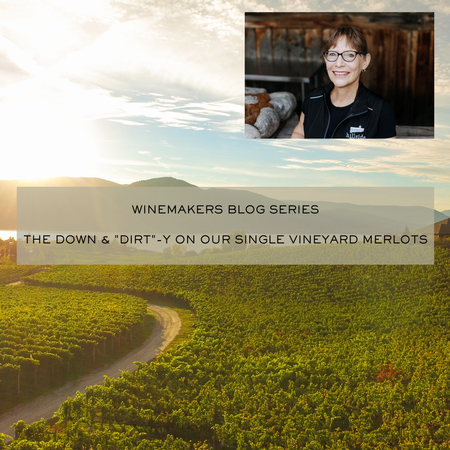Through the summer of 2010, Hillside hosted a number of “terroir tastings” from barrels, illustrating the similarities and differences between four blocks of 2009 Merlot from the Naramata bench and one Oliver block.
The difference was obvious—almost a Sesame Street segment of “one of these things is not like the other” –the wine from Oliver fruit was “benchmark” dark plum Merlot, while the Naramata-sourced fruit was more complex and in addition to the classic merlot flavours, all shared a flavour component attributable to the soil.
I came to characterize this flavour strand as “wet potters’ clay”, which makes perfect sense as, back in the last ice age, the Naramata Bench was the shoreline of Glacial Lake Okanagan. An ice dam had formed just north of Oliver, creating a massive lake stretching from there to Vernon. When that dam let loose, the lovely bluffs of the Naramata Bench were created, and benches of complex, silt and clay-rich, soil exposed, while some 40 feet of lake-bottom sand was deposited in the Oliver-Osoyoos area.
Each Naramata block was distinct, however, and when we started tasting/blending work on the 2009 bordeaux reds, we had fallen in love with two of the vineyards and decided to showcase them in these limited (190 cs or less) offerings.
We are proud to be able to offer our guests the chance to discover these vineyards and appreciate the impact terroir has on the wine.
Gjoa’s Vineyard is located just below Naramata Rd, at Poplar Grove road. An older planting—in 2000, with a complex trellis system (modified Scott Henry). Sloped to the northwest, on fine grained sandy silt.
The vineyard is named after one of the owners, Gjoa Taylor, and we erroneously labelled the first vintage (2009) “Taylor Vineyard” Merlot. It received a stunning review from Beppi Crosorial in the Globe and Mail, which prompted Gjoa to contact us with praise…and the request that we call it by its correct name. I suggested that we might want to leave it as is, capitalizing on brand-awareness, but Gjoa disagreed and, as she has a law degree, we complied. She later explained that the name Gjoa, while difficult for my cellar hands to get their tongues around, has Norwegian roots which involve “God” and “beautiful”.
The wine has reflected the vineyard site in every vintage, showing a deep soy-umami character derived from age of the vines, the silts of the soil and careful canopy management in this north-facing site.
We have just released the 2018 vintage which is no exception
Hidden Valley Vineyard is tucked away above the KVR across Naramata Rd. from Gjoa’s vineyard. This bowl-shaped valley captures and holds heat during the summer, allowing for good ripening in the summer and warm nights late-season, giving grapes the hang-time necessary for full tannin development. Planted in 2001 on soil which was subjected to seasonal flooding during the last glacial period, so sandy gravel with some silt. This block is sloped to the southwest, with a second block sloped to the northwest which is grown for Rosé. The wine is full of bold dark fruit flavours— purple plum and black cherry.
Dickinson Vineyard is “below the road”—Naramata road is accepted as what was the actual shoreline of the glacial lake–this vineyard is perched on a bluff above the lake about halfway from Hillside to Naramata village. Planted in 2006 on a sun-drenched west-facing slope in silt/sand lacustrine (former lake-bottom) soil. This block gets optimum sun exposure throughout the growing season and consistently produces fruit with a distinct cassis flavour, which seems to deepen with each year the vines are in the ground.
Each single vineyard wine is not produced every year, but only in those where we feel the block has shown exceptional promise. The last time the vintages were aligned across the three products was 2012. We are about to offer once again all three with the release of the 2018 vintage. Here’s the vintage report for 2018:
…an average growing season. Budbreak was right on average. The record heat in May hastened bloom, which was about 5 days early. Then the warm but smoke-filled summer brought development and ripening back on track for an exactly average veraison and harvest-start. Smoke cover, from fires to the north, during the hottest periods acted as a shade, preventing sunburn, loss of aromatics and excessive sugar production, while the warmth and long hang-time promoted tannin and flavor ripening.
2018 Gjoa’s Vineyard Merlot was pre-released to wine club with the spring shipment, and to the general public later this month. 2018 Hidden Valley Vineyard Merlot, which just won silver at the All Canadian Wine Awards is on limited pre-release.
The current Dickinson Merlot is from the spectacular 2015 vintage, with the 2016 (92 points from Gismondi-on-Wine https://gismondionwine.com/tasting-notes/202105/hillside-merlot-dickinson-vineyard-2016/?note=34811&ref=search ) on a pre-release to wine club only.
